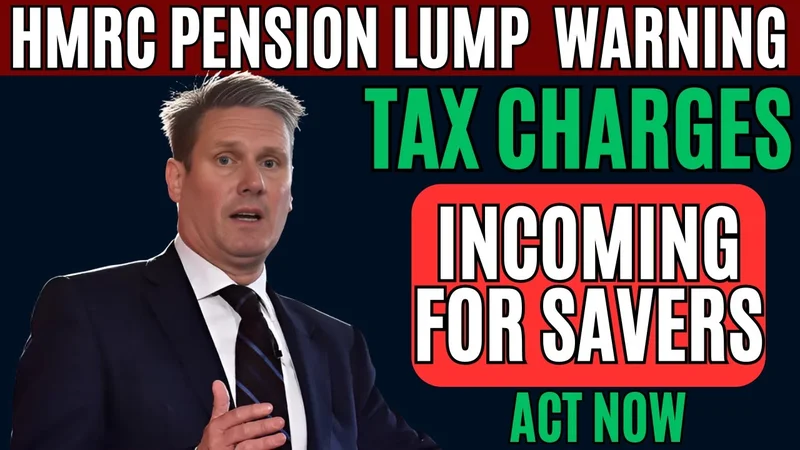The UK's Pension System Glitch: Why This Critical Flaw Signals a Coming Reboot for Finance
It started, as these things often do, with a whisper. A rumor, carried on the digital wind, that the rules of the game were about to change. For millions of people across the UK, their pension pot isn't just a number on a screen; it's the culmination of a lifetime of work, a promise of security, a vessel carrying their future. And suddenly, that vessel felt like it was sailing into a storm.
The rumor was that the government, facing a difficult budget, might cap or even scrap one of the most cherished features of the system: the ability to take 25% of your pension as a tax-free lump sum. Imagine you’ve spent 40 years diligently saving, planning for that moment when you could finally access a piece of your own future, tax-free. Now, imagine being told that window might be about to slam shut. What would you do?
What happened next was a textbook case of human behavior meeting complex systems. A digital stampede. In the 2024-25 fiscal year, a staggering £70 billion was withdrawn from pensions, a 36% jump from the year before. In just six months, the number of people accessing larger pots of over £250,000 surged by more than 50%. This wasn't a market crash driven by failing companies; this was a crisis of confidence driven by a handful of headlines. It's a digital bank run triggered by a whisper, a cascade of clicks and transfers happening in microseconds across the country as thousands of people simultaneously try to safeguard their future based on speculation—a perfect storm of high stakes, imperfect information, and the illusion of control.
Many of these savers acted with what they thought was a safety net. They’d heard of a “30-day cooling-off period.” The logic seemed sound: take the money out now to secure the tax-free status, and if the rumors proved false after the Budget, just put it back. An elegant solution. A reversible decision.
Except it wasn’t.
The System's One-Way Door: A Failure of Empathetic Design
The Ghost in the Machine
This is where the story shifts from a lesson in human psychology to a stark lesson in systems design. It turns out that deep in the intricate code of the UK’s financial regulations, there’s a critical distinction. The tax authority, HMRC, and the financial regulator, the FCA, recently issued a joint clarification that sent a shockwave through the industry. The 30-day cooling-off period simply does not apply to this specific action.

The core of the issue is something called a Pension Commencement Lump Sum, or PCLS—in simpler terms, that's just the official name for your 25% tax-free cash withdrawal. The system doesn't see this as a "contract" you can cancel, like signing up for a new phone plan. It sees it as a permanent, one-time event. Once you press that button, once that payment is made, a flag is permanently tripped in your tax record. You have used your allowance. You can return the money, but you can’t reset the flag. The tax consequences, HMRC confirmed, "will normally stand."
When I first read about this, I honestly felt a knot in my stomach. It’s the digital equivalent of watching someone walk through a one-way door they thought was a swinging door, only to hear it lock permanently behind them. They were acting rationally based on the information they had, but the system’s hidden architecture trapped them. This is the kind of breakthrough in understanding that reminds me why I got into this field in the first place; not just to build new things, but to understand the profound, often invisible, impact that system design has on human lives.
We’re not just talking about an obscure tax rule here. We're talking about a fundamental failure in the user interface of our financial lives. The system presented two conflicting pieces of information: a regulator’s rule about cooling-off periods and a tax authority’s rule about irreversible events. For the end user, the saver, this ambiguity was a trap. As Damon Hopkins at Broadstone noted, these situations lead to "unfortunate consequences for the public." I would reframe that. This isn't just "unfortunate"; it's a critical design flaw. It's an outcome that was predictable for a system that isn't designed with human-centric principles at its core.
This moment feels, in a strange way, like a modern parallel to the age before the printing press. Information was controlled by a few, passed down through complex legal and financial texts that were inaccessible to the average person. The internet was supposed to democratize information, but here we see it amplifying rumor and exposing the dangers of a system whose user manual is still written in a language most of us can't understand. The responsibility here is enormous. When we design systems that manage people's entire life savings, we can't just write code that follows the letter of the law; we have to design with an understanding of human psychology, especially psychology under pressure.
So what happens now? Thousands of people may have inadvertently locked themselves out of a significant financial benefit. They can't undo what they've done. Renny Biggins of TISA rightly called the hardline approach "unduly harsh." He's right. But pointing fingers is the easy part. The real question is, what do we learn from this? How do we build better, more resilient, more empathetic systems for the future? We need systems with clear, unambiguous guardrails. Systems that don't just allow for "undo," but that are designed from the ground up to prevent catastrophic, irreversible errors, especially when users are acting under duress.
This isn't just a pension problem. It's a template for the challenges we will face in every area of our lives as they become more intertwined with complex, opaque digital systems. Can we design systems that are not only powerful, but also wise? Can we build a future where the technology that runs our lives is a trusted partner, not a hidden trap?
The Code of Empathy
This entire episode reveals a profound truth for the 21st century: the most important feature we can build into any system—financial, governmental, or social—is not efficiency or power, but clarity. We have built a world of incredible complexity, but we have forgotten to build a user manual. The future cannot be about creating more intricate rules; it must be about designing systems so intuitive, so transparent, and so fundamentally humane that the user is protected, not penalized, for acting like a human being. That is the next great frontier.
Reference article source:
Related Articles
Zcash's Big Price Pump: What It Is, Why Everyone's Suddenly Talking, and If You Should Care
So, the ghost in the machine is twitching again. Zcash (ZEC), the crypto world’s Schrödinger's cat o...
James May: His Wife, Net Worth, and Life After Top Gear
The public narrative surrounding the dissolution of a 22-year media partnership is typically framed...
The "Aster" Everyone is Suddenly Talking About: A Crypto Breakthrough, Not a Flower
I’ve been watching the digital asset space for a long time, and every so often, you see a moment tha...
The Truth About Allstate Insurance: Quotes vs. Claims and How They Stack Up to Competitors
So, let me get this straight. Allstate—the company whose entire business model is based on profiting...
Emma Stone's Plastic Surgery Speculation: An analysis of the photos and the data behind the rumors
The public appearance of a high-value asset always generates data. On September 30, 2025, that asset...
Pi Network: Value Speculation vs. Testnet Reality
Generated Title: Pi Network's Big Play: Is ISO 20022 a Game-Changer or Just Noise? There's a specifi...





